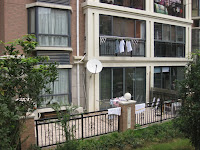As many of you know I have been living in Shanghai, China for the past 2.5 years. Its been a great experience to live in a big city and I’m amazed at how much Shanghai has grown since when I first arrived. With over 20 million people living here, this city is the NYC of Asia, the country’s economic powerhouse and is quickly establishing itself as one of the premier cities in the world. The city’s reputation will be further enhanced next year, when Shanghai hosts the 2010 World Expo.
With a rapidly developing city and more and more people coming here to work, finding a place to live is an important decision for anyone living in Shanghai. For most people coming to China, renting an apartment is the easiest option. Unlike Western countries, one of best advantages to renting in China is most apartments come fully furnished with everything from beds, sofas, televisions, and kitchen appliances. It’s an ideal situation for someone leaving their home country and coming to a foreign land to live and work. For these past couple years I have lived in a furnished 2-bedroom apartment about 30-40 minutes from the downtown. Because of the lower cost of living here in China, my monthly rent is quite reasonable coming in at RMB 2,500 each month (about $365).
According to Chinese culture, one must first arrange some of life’s most important needs before they can settle down. Finding a home, purchasing an automobile, and finding a stable job are probably the three most important things someone can do before looking to settle down. Most Chinese value the purchase of a home as the single most important purchase one can make, so it’s with great honor that I am excited to announce I have taken that first step in Chinese culture and purchased a property here in Shanghai!
I’ve purchased in a rapidly developing part of the city called “Jiu Ting" pronounced “Geo Ting” in English. The property is very unique and I’ll share some interesting facts about the house. The previous owners come from the Northeast part of China that borders South Korea and speak Korean not Mandarin as their native tongue. Despite being Chinese the previous owners are quite partial to Korean culture and it is reflected in the remodeling of the house. One of the most interesting parts of the home is its hardwood flooring. The wood was imported from Korea and installed with a heating system since most people from that area prefer to sleep directly on the floor instead of on a bed.
The "Jiu Ting" area of Shanghai currently has about 200,000 people living there, a large city by Western standards but only a small part of a big city here in China. Located 15 minutes from my work, living here will make life easier with shorter commute and easy access into the downtown as the house is within walking distance to Shanghai's #9 Metro Line. It will take about 4-6 weeks to complete the transaction before I am able to move in but looking forward to moving into the house in mid-October. The next question is who is going to be the first person to come visit me and stay in the house? Here's a breakdown of the pictures:
#1 – Chairman Mao had his little red book, here’s my little green book, the key part in a Shanghai Real Estate deal
#2 – Outside of the compound with guarded security entrance into the property
#3 – Outside the building that’s soon to be called home
#4 – First look at the hardwood floors as seen from the kitchen
#5 – A look standing in the living room
#6 – Bathroom furnished with nice marble and a super deluxe Korean toilet, haha!
#7 – A look from outside the property with a view of the outdoor patio area
#8 – A look at some neighboring apartment buildings in the area
























